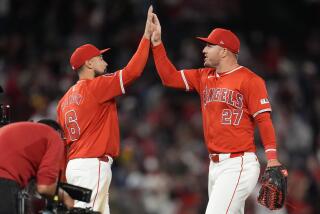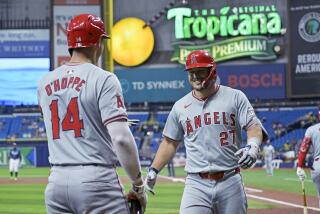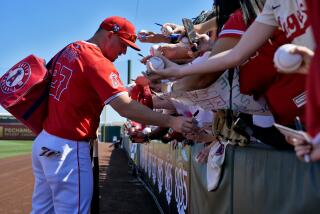A close look at the Angels as spring training begins
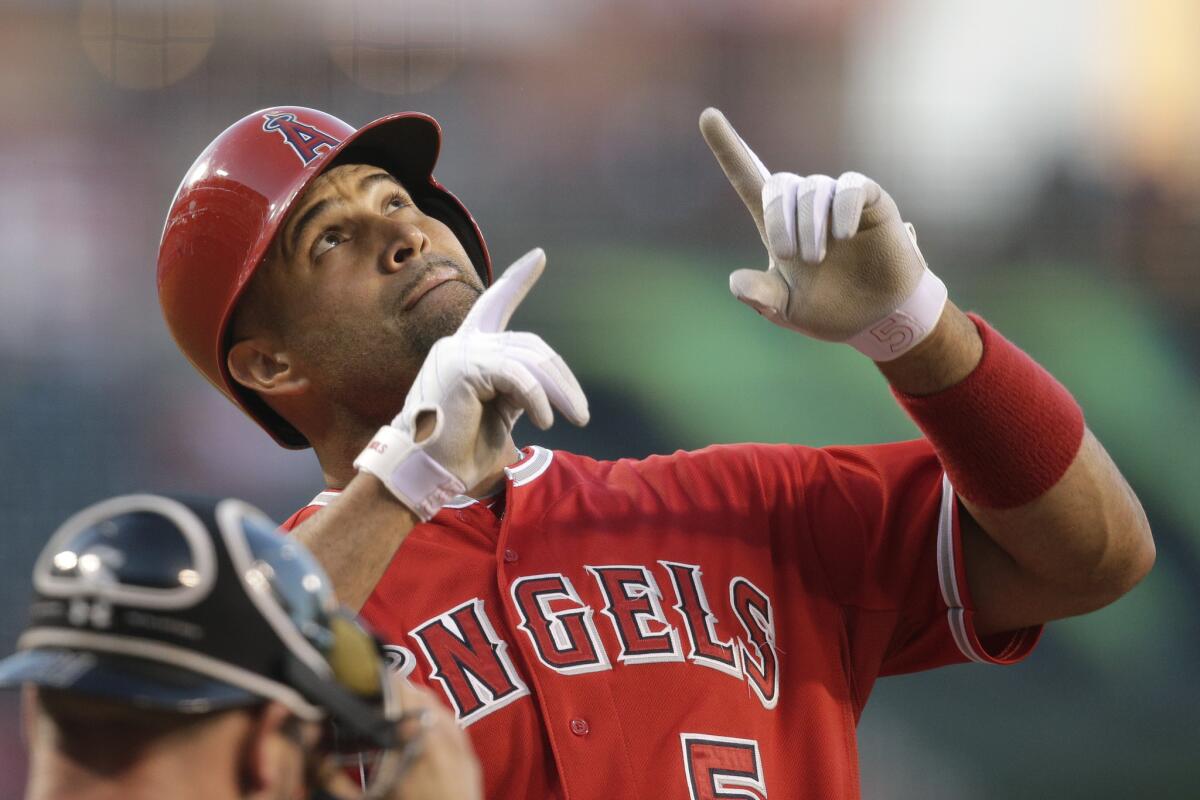
Albert Pujols celebrates a home run against the Chicago White Sox on Aug. 18.
Reporting from Tempe, Ariz. — The Angels did not do what they were expected to do this offseason.
They opted against signing an expensive outfielder to fill an obvious need. Rather, their big move only marginally improved the 2016 team. Shortstop Andrelton Simmons is in. Erick Aybar, worse defensively but better on offense, is out.
The rest of the team returns mostly intact, and the Angels believe they will contend. The rest of baseball is less bullish, believing something closer to mediocrity is in store.
Who is right can begin to be determined Friday, when the team’s pitchers and catchers hold their first workout at Tempe Diablo Stadium.
There should be a spate of story lines to follow during spring training’s six weeks:
Will Albert Pujols, recovering from right foot surgery, be ready for opening day? Maybe.
Does a league-best defensive shortstop and a league-worst defender at second add up to an adequate double-play combination? Probably.
Here are some other important story lines:
Who will compose the starting rotation?
The Angels possess a surplus of pitchers who’ve proven they can competently start major-league games. They have a dearth of pitchers who’ve excelled at it recently.
Over the last three campaigns, Garrett Richards is the only Angel to produce a dominant season. He starred for four-plus months in 2014, then had the patellar tendon in his left knee rip while he was running to cover first base at Fenway Park and missed the stretch run.
He was not the same pitcher when he returned last year, but he is their best pitcher, and an offseason not spent rehabilitating his knee may allow him to improve his command.
Behind Richards, there are seven choices for four spots, most of which seem obvious. Veterans C.J. Wilson and Jered Weaver will begin the season in the rotation if they are healthy. Sophomore left-hander Andrew Heaney should have a spot; he had the best earned-run average among Angels starters after he debuted in June.
That leaves 2015 All-Star Hector Santiago, 2014 Rookie of the Year runner-up Matt Shoemaker, and one-time top prospect Tyler Skaggs competing for the final place. Young right-hander Nick Tropeano, thus far a capable performer in limited major-league time, should be stuck in Triple-A.
Santiago succeeded in limiting his control issues for the first half, earned a surprise All-Star nod, and then reverted back to the same flawed skill set he has demonstrated for most of four major-league seasons. Maybe he will fit better in the bullpen. Shoemaker came out of nowhere to be a force in 2014, but wasn’t as good last year. The left-handed Skaggs has recovered from Tommy John surgery 18 months ago. The organization still values him highly.
Who will play left field, and how well?
After the Angels eschewed the likes of Yoenis Cespedes, Alex Gordon and Justin Upton, their most likely candidates to man left field combined to bat .175 in the majors last season.
They are Daniel Nava and Craig Gentry, both 32, and they are guaranteed $2.38 million between them in 2016 — less than one-ninth of what Cespedes will receive from the New York Mets.
Nava figures to take most of the plate appearances, particularly against right-handed pitching; Gentry could handle left-handers as part of a platoon.
Never drafted, Nava signed with Boston out of an independent baseball league in 2008. By 2013, he was a key contributor to the World Series-winning Red Sox. His career big-league on-base percentage is a solid .358, and the Angels would be well-positioned if he could replicate that this season, even with little power.
Gentry also peaked in 2013, with a .373 on-base percentage in a platoon role for Texas. He spent most of 2015 playing for Oakland’s Triple-A affiliate.
A less likely but intriguing candidate for left field is Rule 5 selection Ji-Man Choi, who has hit .302 with a .404 on-base percentage over five minor-league seasons. Those are impressive numbers, but Choi, 24, appeared in only 97 games in 2014 and 2015. He has been injured and also suspended for testing positive for an anabolic steroid.
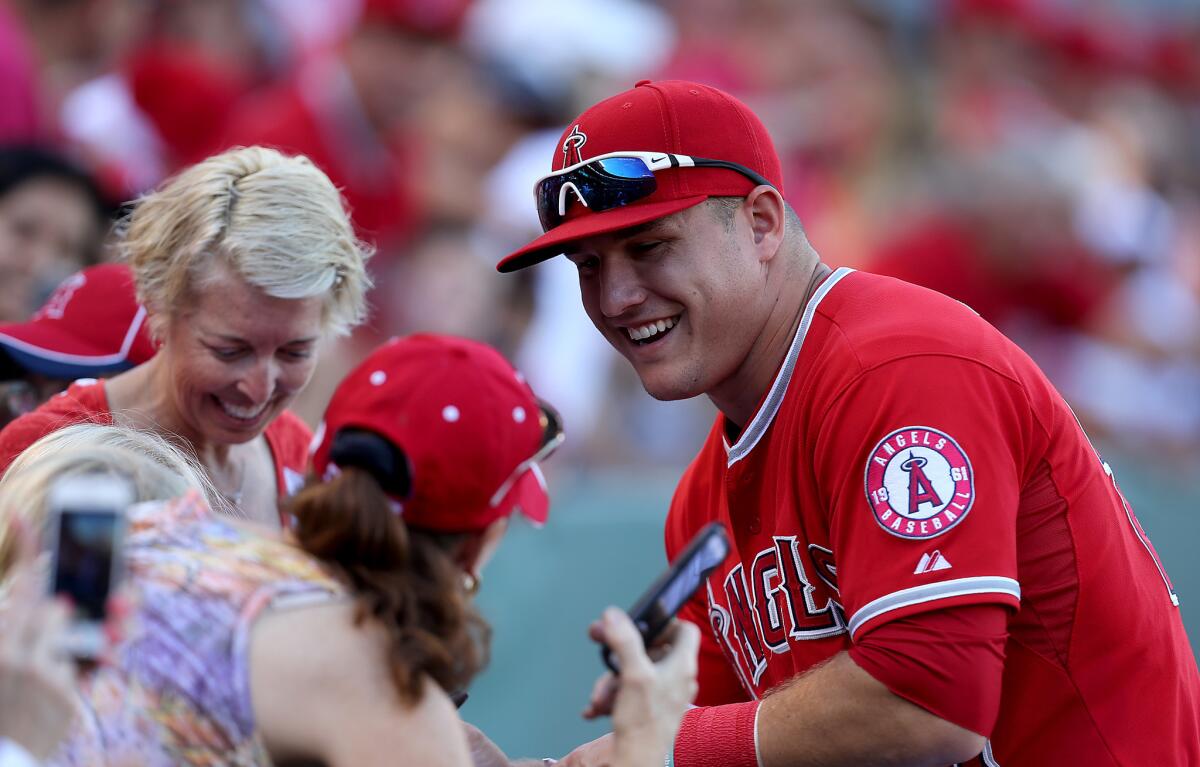
Angels’ Mike Trout interacts with fans before a game against Oakland on Sept. 30.
What’s the long-term plan?
Baseball’s best player plays for the Angels, and, barring the trade to end all trades, will for at least four seasons after this one. Will the team be in position to win the World Series in any of those? The salary scale for Mike Trout supports an attempt to go for it this year or next, before he gets really expensive in 2018.
He will make more than twice as much that year as this one — $34.1 million versus $16.1 million.
Angels owner Arte Moreno is paying veteran pitchers Wilson and Weaver more than $20 million each this season. Both will be off the books for 2017, enabling the Angels to spend significant amounts next offseason. That may be their best chance to win soon.
Because of their so-far foolish investment into Cuban infielder Roberto Baldoquin last year, the Angels cannot sign any high-priced international talent until July 2, 2017. And their minor-league system is generally considered the worst in baseball. So the future does not quite look bright.
What is next for Trout?
Beyond his increasing salary and stardom, Trout has adjusted each season into a different player. One example: When he broke into the big leagues in 2012, his speed was perhaps his most identifiable trait. He swiped 49 bases in 54 tries.
He has made fewer stolen base attempts ever since, transforming into a more traditional power hitter. After last year’s All-Star break, he and Pujols attempted the same number of steals: five.
There have been other adjustments. Pitchers noticed Trout was vulnerable against high fastballs toward the end of the 2014 season; by May of last year, he had corrected himself. He knows he could stand to be more aggressive on first pitches and stop giving away strikes.
It will be interesting to see what adjustments he tries this season.
More to Read
Go beyond the scoreboard
Get the latest on L.A.'s teams in the daily Sports Report newsletter.
You may occasionally receive promotional content from the Los Angeles Times.
